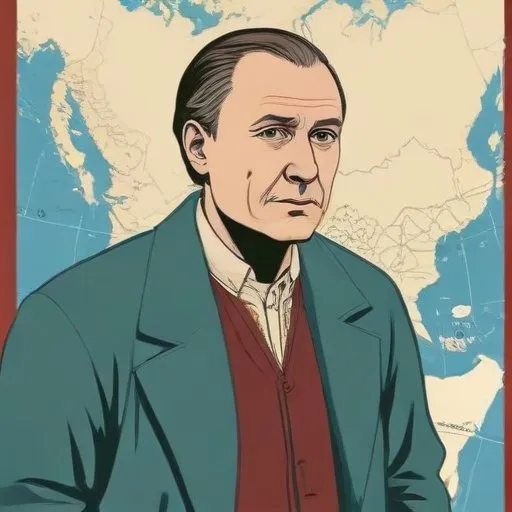Pyotr Semyonov-Tyan-Shansky: The Pioneering Explorer of the Tian Shan Mountains
A Legacy of Discovery and Contribution to Geography
Pyotr Semyonov-Tyan-Shansky is renowned for his groundbreaking exploration of the Tian Shan mountain range, earning him international acclaim and the esteemed title of "Semyonov of Tian Shan". Over four decades, he managed the Russian Geographical Society, leaving an indelible mark on the world of geography and statistics.
Early Life and Education
Born on January 2, 1827, into a noble family, Semyonov-Tyan-Shansky studied at Saint Petersburg University, where he attended secret meetings of the Petrashevsky Circle, a literary discussion group of progressive-minded intellectuals. His fascination with geography and geology led him to Berlin, where he studied under the tutelage of Alexander Humboldt and
Carl Ritter, eventually translating Ritter's writings into Russian.
Pioneering Expeditions and Discoveries
On Humboldt's suggestion, Semyonov-Tyan-Shansky embarked on a remarkable journey to explore the largely unknown Tian Shan mountains. In 1856, he set off from Barnaul, passing through the Altay Mountains and visiting Lake Issyk Kul on his way to the Tian Shan. The following year, he returned to the region, venturing deeper into the mountain range and making several significant discoveries.
Debunking Humboldt's Theory
One of his most notable achievements was disproving Humboldt's earlier claims about the Tian Shan's supposed volcanic origins. Semyonov-Tyan-Shansky's meticulous observations and research revealed no evidence of volcanic activity, revolutionizing the understanding of this majestic mountain range.
Cultural and Personal Milestones
Semyonov-Tyan-Shansky's contributions extended beyond the realm of geography. He was a prolific translator, rendering Ritter's works into Russian, and a dedicated member of the Russian Geographical Society, which he managed for over 40 years. At the age of 79, he changed his surname to Semyonov-Tyan-Shansky, a testament to his deep connection with the Tian Shan.
Family Legacy and Scientific Heritage
Semyonov-Tyan-Shansky's family continued his legacy of scientific excellence. His son, Andrey Semyonov-Tyan-Shansky, and grandson, Oleg Semenov-Tian-Shansky, became prominent scientists in their own right.
Influence on Modern Society and Legacy
Pyotr Semyonov-Tyan-Shansky's groundbreaking work in the Tian Shan mountains paved the way for future generations of geographers, statisticians, and explorers. His contributions have had a lasting impact on our understanding of the natural world, inspiring countless individuals to venture into the unknown.
Awards and Honors
In recognition of his remarkable achievements, Semyonov-Tyan-Shansky was granted the honor of adding "Tian-Shansky" to his surname by Nicholas II of Russia.
Quote
"The Tian Shan is not a land of volcanoes, but a land of mighty mountains, bearing witness to the vast and ancient history of our planet."
― Pyotr Semyonov-Tyan-Shansky
Trivia and Fun Facts
- Semyonov-Tyan-Shansky was the first European to see the scenic panorama of the Tengri Tag, including the majestic Khan Tengri peak.
- He published the first systematic description of the Tian Shan in 1858, which remained a seminal work for decades.
Pyotr Semyonov-Tyan-Shansky's remarkable journey and contributions continue to inspire generations of scientists, explorers, and enthusiasts, cementing his place as one of the most significant figures in the history of geography and statistics.
FAQ
What was Pyotr Semyonov-Tyan-Shanskys contribution to Russian geography?
Pyotr Semyonov-Tyan-Shansky was a Russian geographer and statistician who made significant contributions to the field of Russian geography. He was a pioneer in the study of Russian geography and helped to establish the countrys reputation as a hub of geographical learning.
What was Pyotr Semyonov-Tyan-Shanskys role in the development of the Russian Geographical Society?
Pyotr Semyonov-Tyan-Shansky played a key role in the development of the Russian Geographical Society, where he served as president and helped to guide the organizations research and activities.
What is Pyotr Semyonov-Tyan-Shanskys most famous work?
Pyotr Semyonov-Tyan-Shanskys most famous work is his six-volume study of the Russian Empire, which was a comprehensive and authoritative treatment of the countrys geography and statistics.
Who influenced Pyotr Semyonov-Tyan-Shanskys geographical style?
Pyotr Semyonov-Tyan-Shanskys geographical style was influenced by prominent geographers of the time, including Alexander von Humboldt and Carl Ritter.
What honors did Pyotr Semyonov-Tyan-Shansky receive?
Pyotr Semyonov-Tyan-Shansky received numerous honors for his work, including honorary memberships in several scientific academies and the Order of St. Vladimir.

